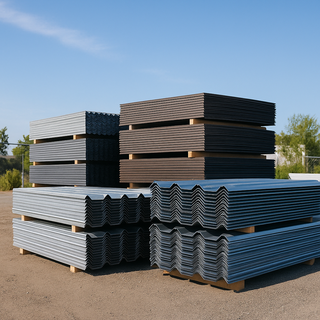One of the most common misconceptions about metal roofs is that they’re noisy. Many homeowners picture heavy rain or hail creating a deafening roar inside the house. But here’s the truth: when properly installed with the right materials, a metal roof can be just as quiet—or even quieter—than traditional roofing systems.
In this comprehensive guide, we’ll explore the science of sound on metal roofs, the factors that influence noise levels, and the best strategies to soundproof your metal roof for a peaceful, quiet living environment.
1. Understanding Why Metal Roofs Can Be Noisy
A metal roof doesn't have to be noisy—but in certain conditions, it can be. Here's why:
-
Metal is a conductive material that can amplify vibrations.
-
Thin panels without solid decking beneath can create a drum-like effect.
-
Exposed fastener systems can vibrate more than standing seam systems.
-
Lack of proper underlayment or insulation leaves no buffer between the metal and your interior.
The main culprits? Poor installation practices and lack of sound-dampening materials.
2. Sound vs. Vibration: What You're Actually Hearing
What most people perceive as "noise" from a metal roof is actually a combination of:
-
Impact noise (from rain, hail, or debris hitting the roof)
-
Airborne noise (wind or outdoor sounds)
-
Structural vibration (when metal panels resonate with the impact)
A properly installed metal roof on a solid deck with underlayment significantly reduces all three.
3. Key Factors That Influence Noise Levels
A. Roof Decking Material
-
A solid plywood or OSB deck beneath your metal panels acts like a silencer.
-
Avoid installing directly over open rafters or battens unless using insulated panels.
B. Underlayment Type
-
The underlayment between the roof deck and metal panels is critical for sound reduction.
-
Standard synthetic underlayment provides minimal sound absorption.
-
Specialized acoustic or high-density underlayments make a significant difference.
C. Panel Profile and Thickness
-
Heavier gauge metal (24 or 26 gauge) vibrates less than thinner options.
-
Standing seam panels are more stable and quieter than corrugated or exposed fastener panels.
D. Insulation
-
Attic insulation helps absorb sound from above.
-
Spray foam insulation on the underside of the deck offers superior noise dampening.
E. Attic Ventilation and Air Gaps
-
Proper airflow through ridge and soffit vents prevents reverberation and echo chambers in the attic space.
4. Best Products for Soundproofing a Metal Roof
Here are materials commonly used to reduce noise:
A. Acoustic Underlayment Options
-
MBTechnology LayFast Ultra HT – self-adhered and dampens impact sounds.
-
ShingleLayment® 300 HT – high-performance sound and moisture barrier.
-
Specialty foam underlayments – custom-designed for sound absorption beneath metal panels.
B. Roof Deck Enhancements
-
Use 2x decking or plywood over OSB for a sturdier base.
-
Add resilient channels or rubber strips between deck and panel for vibration isolation.
C. Insulation Methods
-
Spray foam insulation: Expands and seals gaps while absorbing vibrations.
-
Blown-in fiberglass or cellulose: Budget-friendly and effective when installed thickly.
-
Rigid foam boards: Offer thermal and acoustic benefits under the decking.
5. How to Retrofit Soundproofing to an Existing Metal Roof
If you already have a metal roof and experience excessive noise, here are your options:
A. From Inside the Attic:
-
Add or upgrade attic insulation.
-
Apply spray foam directly beneath the roof deck.
-
Install acoustic panels on the ceiling below the attic space.
B. From the Roof (During Reroofing or Renovation):
-
Add or upgrade underlayment with acoustic performance.
-
Use a sound-deadening mat or resilient barrier between the deck and panels.
-
Upgrade to thicker metal panels or standing seam profiles.
6. Bonus: How Climate and Roof Pitch Affect Noise
-
Low-slope roofs typically receive more impact from rain, increasing noise.
-
Steeper pitches shed water faster, reducing prolonged contact and noise duration.
-
Homes in dry climates naturally experience fewer rain events, making this a less critical concern.
7. Comparing Metal Roof Noise to Other Roofing Materials
| Roofing Type | Soundproofing Needs | Average Noise Level | Notes |
|---|---|---|---|
| Metal Roof (with deck + underlayment) | Moderate | Low–Moderate | Can be as quiet as asphalt |
| Metal Roof (over battens) | High | High | Prone to drumming without insulation |
| Asphalt Shingles | Low | Low | Naturally quieter, but lower lifespan |
| Clay/Concrete Tiles | Moderate | Low–Moderate | Heavy, absorbs impact well |
| Wood Shakes | Low | Moderate | Softer material, but not durable |
8. Real-World Feedback from Homeowners
“After replacing our asphalt roof with a standing seam metal roof and adding spray foam in the attic, our home is actually quieter than before. We were worried about rain noise, but we don’t hear anything now.”
– Kelly R., North Carolina
“We initially installed corrugated panels directly over purlins on our garage. When it rained, it sounded like a drum. Adding OSB decking and foam underlayment solved it completely.”
– Sam L., Texas
Conclusion: Silence Is Possible with the Right Metal Roof Setup
A modern metal roof doesn’t have to be noisy. In fact, with proper materials, installation techniques, and insulation, a metal roof can provide the same or better sound insulation than traditional roofing systems.
Whether you're designing a new build or updating an existing structure, investing in the right sound-dampening layers can bring you all the benefits of metal roofing—without sacrificing peace and quiet. By planning wisely, you get beauty, performance, and comfort under one roof.






